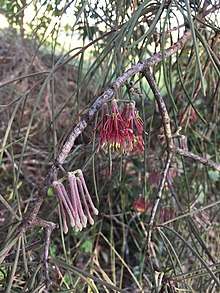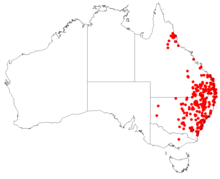Amyema cambagei
Amyema cambagei, commonly known as sheoak mistletoe, is a species of flowering plant, an epiphytic hemiparasitic plant of the family Loranthaceae endemic to Australia, and found in New South Wales and Queensland in sclerophyll forest and woodland on several species of Casuarinaceae.[3]
| Amyema cambagei | |
|---|---|
 | |
| Scientific classification | |
| Kingdom: | Plantae |
| Clade: | Tracheophytes |
| Clade: | Angiosperms |
| Clade: | Eudicots |
| Order: | Santalales |
| Family: | Loranthaceae |
| Genus: | Amyema |
| Species: | A. cambagei |
| Binomial name | |
| Amyema cambagei | |
 | |
| Collections data for A. cambagei from the Australasian Virtual Herbarium [2] | |
Description
This mistletoe is spreading to pendulous plant with grey hairy stems. Leaves are terete, usually 6–15 cm long and 1–1.5 mm. The flowers are 15-21mm long and are pink with white hairs. [4] Flowers appear in winter to early summer (June to December). [3] Fruits are globular, pink to red, 5–6 mm diam. [4]
Ecology
A. cambagei is found on Casuarina & Allocasuarina spp., mimicking the leaves of the host.[3]
Taxonomy
A. cambagei was first described by Blakely in 1922 as Loranthus cambagei,[5], but in 1929 was placed in the genus Amyema by Danser.[1][6]
References
- "Amyema cambagei". Australian Plant Name Index (APNI), IBIS database. Centre for Plant Biodiversity Research, Australian Government, Canberra. Retrieved 29 March 2019.
- "AVH: Amyema cambigei (mapview), Australasian Virtual Herbarium". Retrieved 29 March 2019.
- Fairley, Alan; Moore, Philip (2010). Native Plants of the Sydney District: From Newcastle to Nowra and west to the Dividing Range (3rd ed.). Crows Nest, New South Wales: Allen & Unwin. p. 362.
- "Amyema cambagei". PlantNET - New South Wales Flora Online. Royal Botanic Gardens & Domain Trust, Sydney Australia. Retrieved 29 March 2019.
- Blakely, W.F. 1922. The Loranthaceae of Australia. Part iii. Proceedings of the Linnean Society of New South Wales 47(4): 392
- Danser, B.H. 1929. On the taxonomy and nomenclature of the Loranthaceae of Asia and Australia. Bulletin du Jardin Botanique de Buitenzorg ser. 3, 10(3): 295